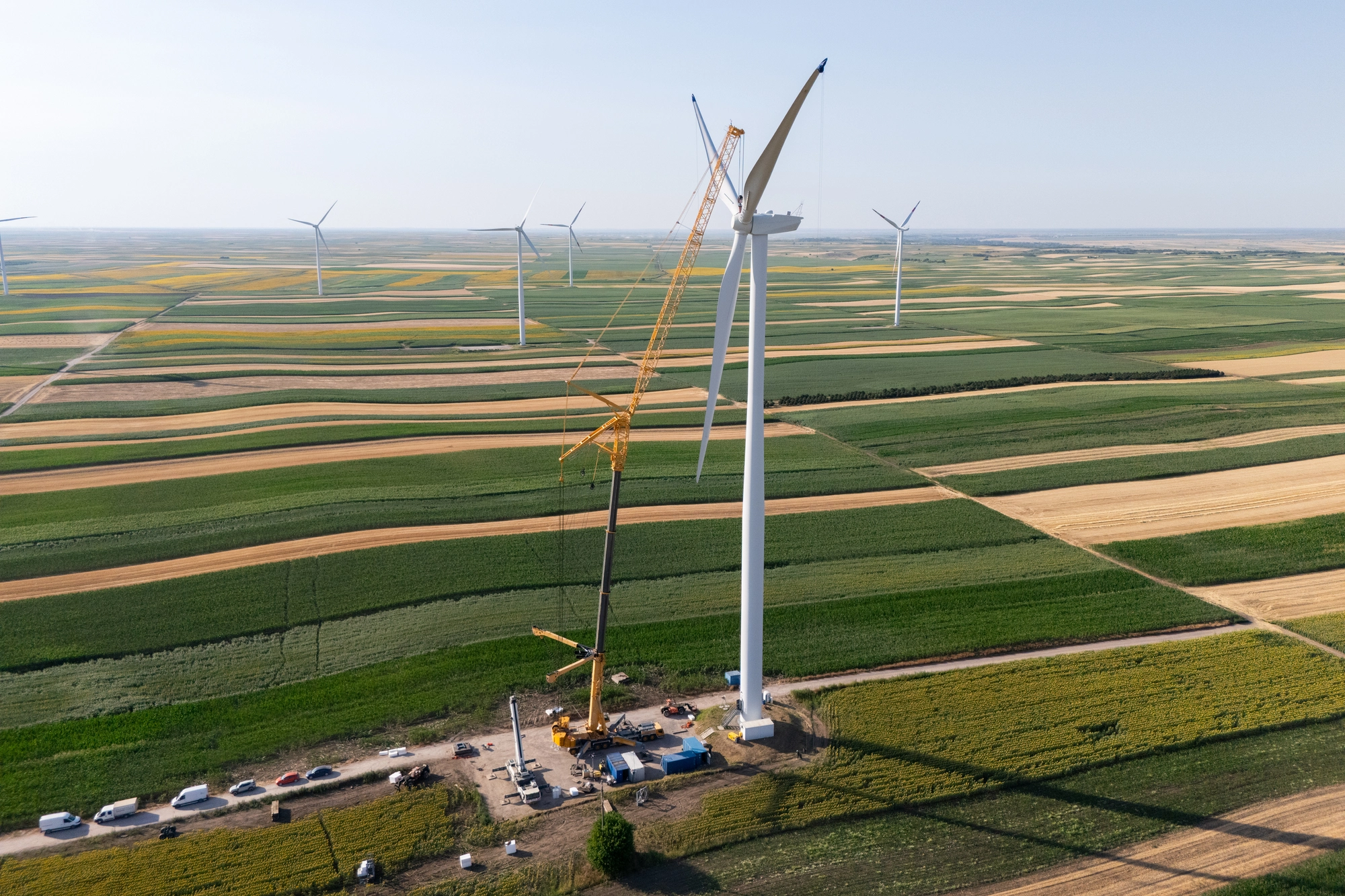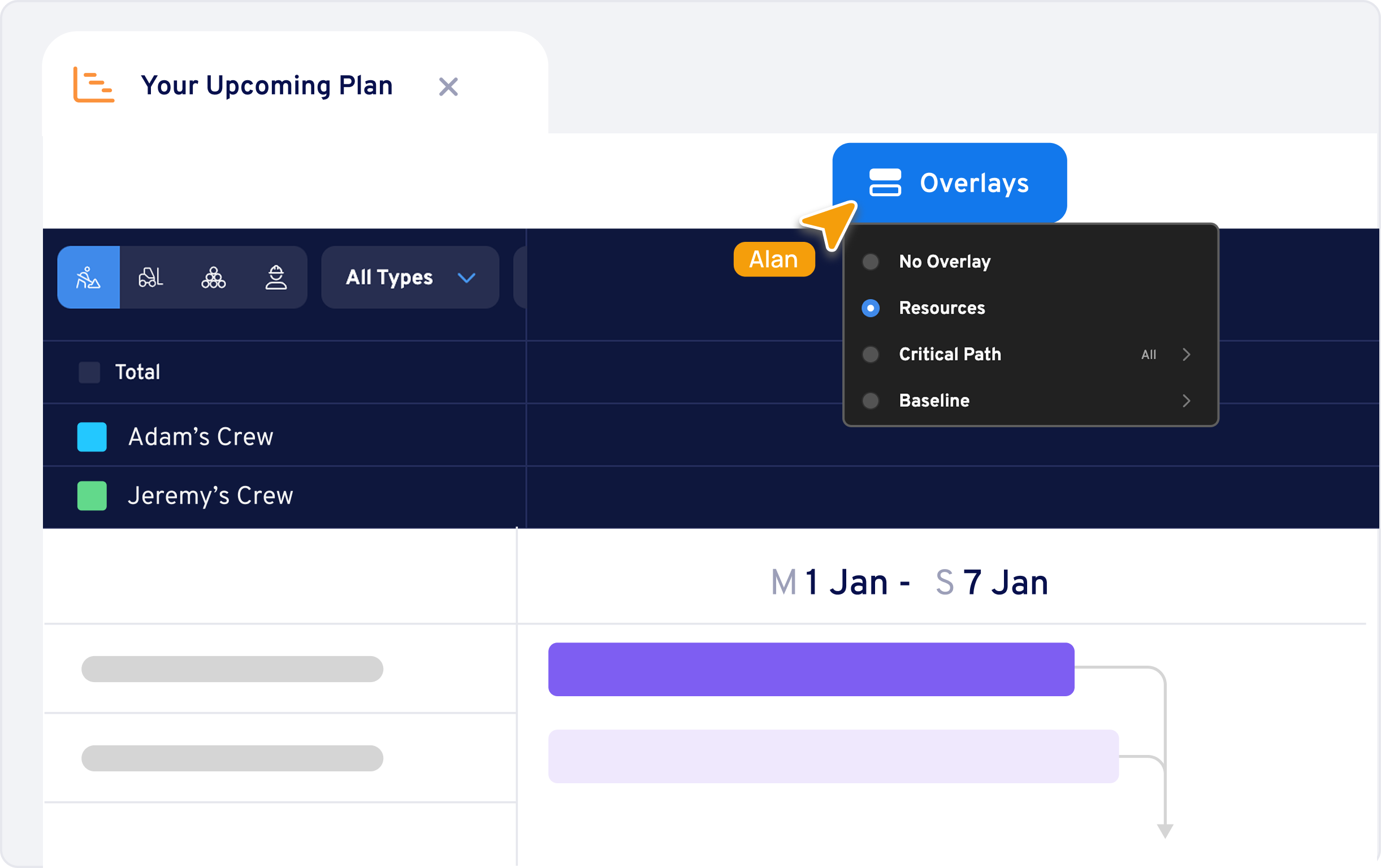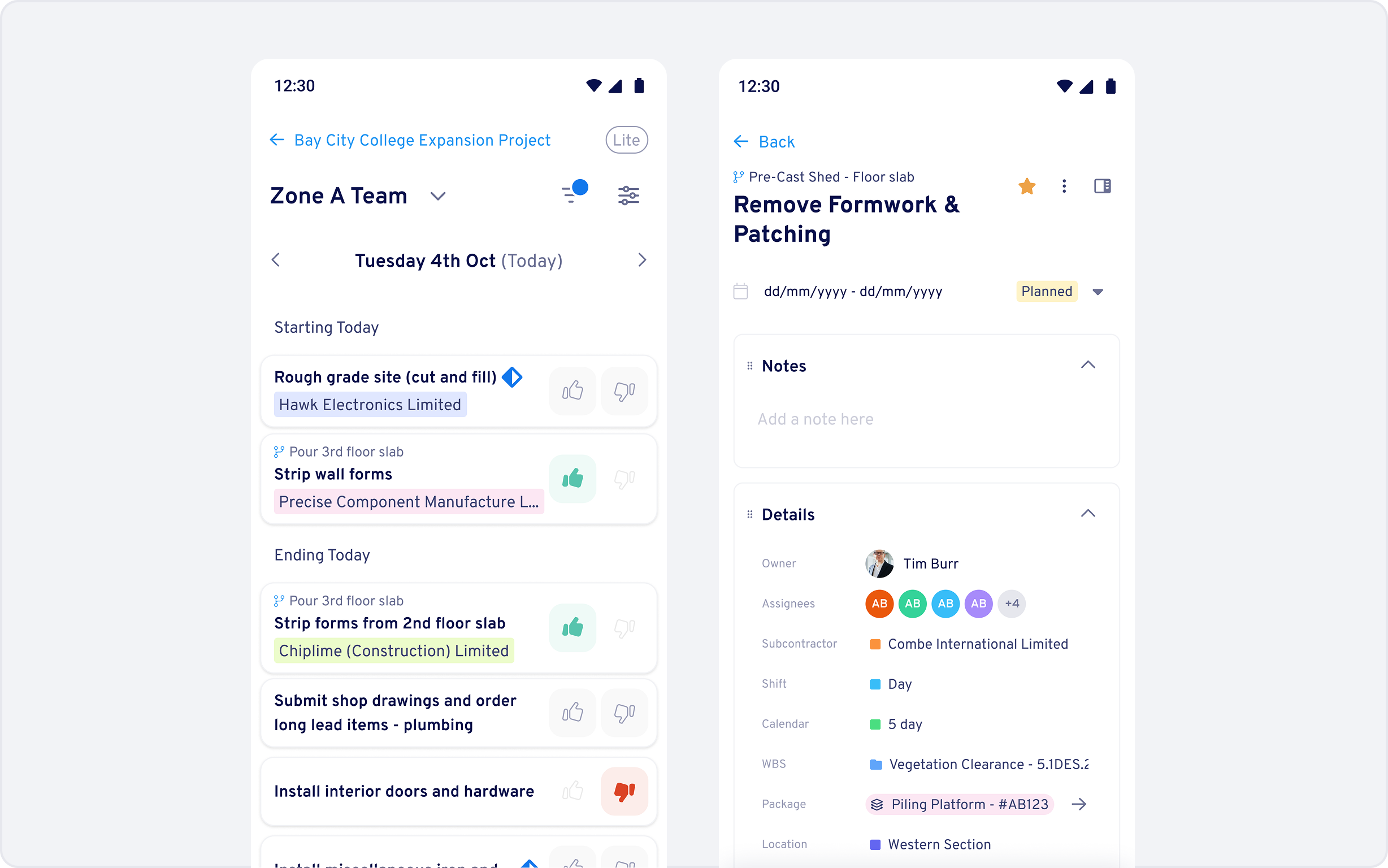The challenge of coordinating subcontractors alongside specialist resources
When building on a greenfield site with ecological and cultural sensitivities, construction teams face a coordination challenge that extends far beyond traditional subcontractor management. Ground disturbance can require cultural heritage monitors to be present. Fauna spotters might be needed on-site before any clearing can begin. Ecologists need to complete assessments before work areas can be accessed.
These specialist resources can't be summoned at short notice—they require weeks of advance planning and booking. And if their work isn't done when subcontractors arrive, entire work programs can grind to a halt. And you can't simply request 10% more fauna spotters if the work takes longer than expected.
The challenge becomes even more complex because subcontractors typically aren't involved in planning the predecessor tasks that must be completed before their work can begin. This creates coordination gaps that can lead to delays.
We spoke with senior project engineers on a major wind farm project to see how they manage these coordination challenges.

The wind farm project
The project involves constructing stage one of a wind farm development in Australia, comprising 38 turbines, 41 kilometers of internal access tracks, a substation, and supporting infrastructure.
The scope also includes external works such as an access road from the main highway and a switching station yard to connect back into the electrical network.
As a greenfield development, every aspect of the site requires careful coordination between main construction activities and specialised environmental and cultural compliance requirements. The project operates under strict regulatory oversight with zero tolerance for unauthorised ground disturbance or ecological impacts.

Why subcontractor management fails in complex projects
Traditional subcontractor management approaches can break down when projects involve multiple specialist resource dependencies that must be coordinated before main construction work can begin.
Here’s why:
Subcontractors lack project context
Subcontractors arrive on-site focused on their specific scope of work. They are typically unaware of broader project dependencies, timing constraints, or how their work impacts other trades and specialist resources. They often don't understand the critical path relationships or the cascading effects of delays in their deliverables.
Resource forecasting is inflexible
Specialist environmental and cultural compliance resources can't be adjusted day to day like typical construction crews. Cultural heritage monitors and fauna spotters must be booked weeks in advance, and there's little flexibility to increase capacity mid-project if the project runs longer than planned.
Traditional tools aren't built for resource coordination
Microsoft Project and Excel combinations require significant setup time and expertise to connect resource requirements to specific tasks. The tools aren't visually intuitive, making it challenging to communicate resource plans to supervisors and subcontractors who need to understand what's happening when and where.
The result is projects where the main construction work gets delayed because predecessor specialist resources weren't properly planned or coordinated, causing cascading impacts across the entire program.

The team's approach: connect resources to tasks for proactive coordination
The wind farm team's solution centered on three key principles: make resource ownership visible, establish shared visual coordination, and capture daily progress rather than weekly.
The breakthrough insight was that most delays stem from unclear accountability for specialist resources. By connecting every task to a specific owner and the associated resource requirements, problems could be identified and solved before subcontractors arrived on-site, expecting to begin work.
Solution 1: Clear ownership of specialist resources
The challenge with specialist environmental and cultural compliance resources is that they're often treated as separate from the main construction program. Teams book them as needed without clear integration into task-level planning.
The wind farm team assigned a specific owner to every task that required specialist resources, making it clear who was responsible for ensuring cultural heritage monitors, fauna spotters, and ecologists would be available when needed. This created direct accountability and made resource conflicts visible immediately, rather than on the day work was supposed to begin.
The team used the resource planning functionality to forecast requirements weeks in advance, showing exactly where each type of specialist would be needed across the site. This allowed them to identify potential shortfalls early and adjust the program before subcontractors were impacted.
When problems arose—such as a cultural heritage crew going to the wrong location or insufficient fauna spotters being available—the system clearly showed which engineer was responsible for that particular area, enabling immediate communication and resolution.
How to implement in Aphex: Resources
Start by setting up your resource categories to include all specialist requirements beyond typical construction crews. Create categories for cultural heritage monitors, fauna spotters, ecologists, and any other compliance-related resources your project requires.
Assign resource requirements and ownership to each task during initial planning. Use Aphex's labour tab to specify exactly how many of each specialist resource type will be needed for each activity, and assign a clear owner who is accountable for ensuring these resources are available.
Use the resource overlay feature to visualise resource demand across your program timeline. This makes it easy to spot periods where you'll need multiple fauna spotters or cultural heritage crews, allowing you to book resources weeks in advance rather than discovering conflicts the day work is supposed to begin.
Review resource allocation daily using the resource view to confirm that planned resources match actual requirements and that the right people are in the right locations.

Solution 2: Shared maps to coordinate multiple work areas
With multiple engineering teams managing different sections of a large site, coordination becomes challenging when everyone maintains separate work area plans. Traditional approaches rely on one person creating and updating site maps, which quickly become bottlenecks and often don't reflect real-time changes.
The wind farm team implemented shared mapping, where each engineer could define their own work areas directly on the site map. The system automatically detects when work areas overlap on the same day, immediately highlighting potential clashes that need to be resolved.
This approach becomes particularly valuable as more subcontractors mobilise to the site. Rather than relying on weekly meetings to identify conflicts, clashes are visible immediately when engineers draw their planned work areas. The visual nature of the maps also makes it easy to communicate work locations to subcontractors without requiring them to interpret complex Gantt charts or schedules.
Engineers found the map functionality essential for maintaining accuracy—work areas must be precisely defined, as the system flags any overlap as a potential clash, encouraging careful planning and clear boundaries between different work activities.
How to implement in Aphex: Work areas
Import your site layout and GIS data into Aphex to create accurate base maps that all team members can reference. Link your planned activities to specific geographic locations on these maps.
Train each engineer to draw their own work areas directly on the map for the activities they're managing. Use Aphex's work area overlay feature to mark out zones for different activities, with clear boundaries that reflect actual site conditions.
Enable automatic clash detection so that when engineers schedule overlapping activities in the same area, the system visually highlights these conflicts on the map. This prompts immediate discussion about sequencing and coordination rather than waiting for conflicts to emerge on-site.
Use the maps as communication tools with subcontractors, providing clear visual representations of where their work will take place and how it relates to other activities.

Solution 3: Daily progress updates through mobile app
Getting timely progress information from subcontractors is notoriously difficult. Traditional approaches rely on weekly progress meetings where delays are discovered after they've already impacted the program. Complex project management tools are often too difficult for supervisors to use consistently.
The wind farm team implemented a simple mobile-based progress-capture system in which subcontractor supervisors provide a daily thumbs-up or thumbs-down on task progress. These updates flow directly into the main program, making delays visible immediately rather than waiting for formal progress reports.
The simplicity of the thumbs-up/down system was crucial for adoption. Supervisors could quickly update task status from their mobile phones without needing training on complex software or spending significant time on administrative tasks.
This daily feedback created immediate accountability. When subcontractors claimed delays weren't their responsibility, the team could pull up detailed day-by-day progress data showing exactly when tasks were marked as not progressing and what reasons were given. This level of detail supported commercial discussions and helped identify recurring issues that needed systematic solutions.
How to implement in Aphex: Mobile app
Set up mobile access for all subcontractor supervisors and provide basic training on the thumbs up/thumbs down functionality. Focus on making the process as quick and simple as possible to encourage daily adoption.
Establish a routine where supervisors review their assigned tasks each day and provide status updates. The mobile interface shows only the tasks relevant to each supervisor, avoiding information overload.
Use the daily status data to identify trends and issues early. When tasks consistently show delays, use the detailed progress history to have specific conversations with subcontractors about solutions rather than general discussions about program performance.
Create regular data exports to support commercial discussions and program reviews, using the detailed daily progress information to demonstrate actual progress against planned milestones.

Results: Improved coordination and reduced delays
The wind farm team's approach to subcontractor coordination delivered measurable improvements in program management and resource utilisation:
Streamlined engineering workflow
Engineers could delegate detailed programming tasks to team members while maintaining oversight through the shared platform. This freed up senior engineers to focus on reviewing programs and solving problems rather than spending time on administrative tasks and data entry.
Early conflict detection
The shared mapping approach caught work area conflicts before they became on-site clashes. Engineers reported that automatic clash detection prevented coordination problems that would have otherwise emerged during construction.
Improved subcontractor accountability
Daily progress updates created clear accountability for subcontractors. The detailed progress history provided objective data for commercial discussions and helped identify recurring issues that needed systematic solutions rather than ad-hoc fixes.

What you can apply: Four principles for complex subcontractor coordination
1. Make specialist resource ownership explicit
Many coordination problems stem from unclear accountability for specialist resources that must be in place before main construction can begin. Assign specific owners to tasks that require environmental monitors, compliance specialists, or other predecessor resources, and track these requirements at the same level of detail as your main construction activities.
2. Use shared visual tools that don't require specialised skills
Traditional project management tools often create barriers between different team members who need to coordinate but don't have the same technical background. Implement visual coordination tools that allow engineers, supervisors, and subcontractors to understand work relationships without needing to interpret complex Gantt charts or schedules.
3. Capture progress information daily, not weekly
Weekly progress meetings discover problems after they've already impacted your program. Implement simple daily progress capture that requires minimal time investment but provides immediate visibility into emerging issues. The key is making the process simple enough that people will actually do it consistently.
4. Connect resource planning to task-level accountability
Resource shortfalls often aren't discovered until the day work is supposed to begin. Connect resource requirements directly to specific tasks and owners during initial planning, allowing you to forecast requirements weeks in advance and identify conflicts before they cause delays.

Heading
Lorem ipsum dolor sit amet, consectetur adipiscing elit. Suspendisse varius Duis cursus,

.webp)

.webp)




